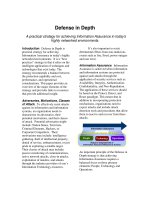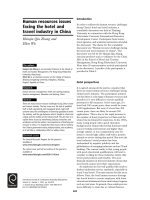Tài liệu eadings in Applied Microeconomics: The Power of the Market pdf
Bạn đang xem bản rút gọn của tài liệu. Xem và tải ngay bản đầy đủ của tài liệu tại đây (2.71 MB, 458 trang )
Readings in Applied Microeconomics
A central concern of economics is how society allocates its resources. Modern
economies rely on two institutions to allocate: markets and governments. But
how much of the allocating should be performed by markets and how much by
governments? This collection of readings will help students appreciate the
power of the market. It supplements theoretical explanations of how markets
work with concrete examples, addresses questions about whether markets
actually work well and offers evidence that supposed “market failures” are not
as serious as claimed.
Featuring readings from Friedrich Hayek, William Baumol, Harold
Demsetz, Daniel Fischel and Edward Lazear, Benjamin Klein and Keith B.
Leffl er, Stanley J. Liebowitz and Stephen E. Margolis, and John R. Lott, Jr.,
this book covers key topics such as:
• Why markets are effi cient allocators
• How markets foster economic growth
• Property rights
• How markets choose standards
• Asymmetric Information
• Whether fi rms abuse their power
• Non-excludable goods
• Monopolies
The selections should be comprehended by undergraduate students who have
had an introductory course in economics. This reader can also be used as a
supplement for courses in intermediate microeconomics, industrial organiza-
tion, business and government, law and economics, and public policy.
Craig M. Newmark is Associate Professor of Economics at North Carolina
State University, USA. His research focuses on U.S. antitrust policy and
has been published in the Journal of Political Economy, Journal of Law
and Economics, Review of Economic Statistics, and other journals. He teaches
graduate courses in microeconomics and writing for economists, and an
undergraduate course on the moral foundations of capitalism.
Readings in Applied
Microeconomics
The power of the market
Edited by
Craig M. Newmark
First published 2009
by Routledge
2 Park Square, Milton Park, Abingdon, Oxon, OX14 4RN
Simultaneously published in the USA and Canada
by Routledge
270 Madison Avenue, New York, NY 10016
Routledge is an imprint of the Taylor & Francis Group,
an informa business
© 2009 selection and editorial matter; Craig Newmark,
individual chapters; the contributors
All r
ights reserved. No part of this book may be reprinted or reproduced
or utilized in any form or by any electronic, mechanical, or other means,
now known or hereafter invented, including photocopying and recording,
or in any information storage or retrieval system, without permission in
writing from the publishers.
British Library Cataloguing in Publication Data
A catalogue record for this book is available from the British Library
Library of Congress Cataloging in Publication Data
Readings in applied microeconomics: the power of the market / edited by Craig Newmark.
p. cm.
Includes bibliographical references and index.
1. Microeconomics. I. Newmark, Craig.
HB 172.R328 2009
338.5 dc22
2008046385
ISBN13: 978-0-415-77739-1 (hbk)
ISBN13: 978-0-415-77740-7 (pbk)
ISBN13: 978-0-203-87846-0 (ebk)
INBN10: 0-415-77739-9 (hbk)
INBN10: 0-415-77740-2 (pbk)
INBN10: 0-203-87846-9 (ebk)
This edition published in the Taylor & Francis e-Library
, 2009.
To purchase your own copy of this or any of Taylor & Francis or Routledge’s
collection of thousands of eBooks please go to www.eBookstore.tandf.co.uk.
ISBN 0-203-87846-9 Master e-book ISBN
To my wife, Betsy, and to my children, Katie and Meredith
Notes on Contributors xi
Acknowledgments xiii
Preface xvii
PART ONE
Information and Incentives
Introduction
2
1 F. A. Hayek 4
THE USE OF KNOWLEDGE IN SOCIETY
2 Leonard E. Read 14
I, PENCIL
3 Charles Maurice and Charles W. Smithson 19
THE TIMBER CRISIS
AND
AMERICA’S FIRST OIL CRISIS
4 Steven Horwitz 38
MAKING HURRICANE RESPONSE MORE EFFECTIVE:
LESSONS FROM THE PRIVATE SECTOR AND THE COAST GUARD DURING KATRINA
5 Michael T. Maloney and J. Harold Mulherin 61
THE COMPLEXITY OF PRICE DISCOVERY IN AN EFFICIENT MARKET:
THE STOCK MARKET REACTION TO THE CHALLENGER CRASH
Contents
PART TWO
Creating Value
Introduction
90
6 William J. Baumol 91
ENTREPRENEURSHIP: PRODUCTIVE, UNPRODUCTIVE, AND DESTRUCTIVE
7 Ronald Bailey 115
THE LAW OF INCREASING RETURNS
8 Russell Roberts 124
THE GREAT OUTSOURCING SCARE OF 2004
9 Geoffrey Colvin 128
WE’RE WORTH OUR WEIGHT IN PENTIUM CHIPS
10 W. Michael Cox and Richard Alm 131
THESE ARE THE GOOD OLD DAYS: A REPORT OF U.S. LIVING STANDARDS
PART THREE
Property Rights
Introduction
156
11 Harold Demsetz 157
TOWARD A THEORY OF PROPERTY RIGHTS
12 Robert C. Ellickson 169
A HYPOTHESIS OF WEALTH-MAXIMIZING NORMS: EVIDENCE
FROM THE WHALING INDUSTRY
13 Michael Satchell 183
SAVE THE ELEPHANTS: START SHOOTING THEM
PART FOUR
Externalities and Coordination Problems
Introduction
190
14 Michael C. Munger 192
ORANGE BLOSSOM SPECIAL: EXTERNALITIES AND THE COASE THEOREM
15 Fred E. Foldvary and Daniel B. Klein 197
THE HALF-LIFE OF POLICY RATIONALES: HOW NEW
TECHNOLOGY AFFECTS OLD POLICY ISSUES
viii CONTENTS
16 S. J. Liebowitz and Stephen E. Margolis 208
THE FABLE OF THE KEYS
PART FIVE
Non-Excludable Goods
Introduction
232
17 John R. Lott, Jr. 233
COMMERCIALIZATION OF RADIO
18 Daniel B. Klein 235
PRIVATE HIGHWAYS IN AMERICA, 1792–1916
19 Richard L. Stroup 241
FREE RIDERS AND COLLECTIVE ACTION REVISITED
PART SIX
Asymmetric Information
Introduction
258
20 Benjamin Klein and Keith B. Leffl er 259
THE ROLE OF MARKET FORCES IN ASSURING CONTRACTUAL PERFORMANCE
21 Clement G. Krouse 279
BRAND NAME AS A BARRIER TO ENTRY: THE REALEMON CASE
22 Steven N. Wiggins and David G. Raboy 289
PRICE PREMIA TO NAME BRANDS: AN EMPIRICAL ANALYSIS
23 John R. Lott, Jr. 299
A SOUR LEMON STORY
24 Eric W. Bond 303
A DIRECT TEST OF THE “LEMONS” MODEL: THE MARKET FOR
USED PICKUP TRUCKS
PART SEVEN
Monopoly and Collusion
Introduction
312
25 David Hemenway 313
THE ICE TRUST
CONTENTS ix
26 Harold Demsetz 326
INDUSTRY STRUCTURE, MARKET RIVALRY, AND PUBLIC POLICY
27 Craig M. Newmark 334
DOES HORIZONTAL PRICE FIXING RAISE PRICE? A LOOK AT THE
BAKERS OF WASHINGTON CASE
28 Craig M. Newmark 349
PRICE AND SELLER CONCENTRATION IN CEMENT: EFFECTIVE
OLIGOPOLY OR MISSPECIFIED TRANSPORTATION COST?
PART EIGHT
Abuse of Firm Power
Introduction
360
29 Eugene Silberberg 361
SHIPPING THE GOOD APPLES OUT
30 Daniel R. Fischel and Edward P. Lazear 366
COMPARABLE WORTH AND DISCRIMINATION IN LABOR MARKETS
31 Harold Demsetz and Kenneth Lehn 383
THE STRUCTURE OF CORPORATE OWNERSHIP: CAUSES
AND CONSEQUENCES
32 Charles R. Knoeber 402
GOLDEN PARACHUTES, SHARK REPELLENTS, AND HOSTILE
TENDER OFFERS
33 Benjamin Klein 419
TRANSACTION COST DETERMINANTS OF “UNFAIR” CONTRACTUAL
ARRANGEMENTS
34 John R. Lott, Jr. 428
TWO EXCERPTS FROM FREEDOMNOMICS
x CONTENTS
Notes on Contributors
Richard Alm is Senior Economics Writer at the Federal Reserve Bank of
Dallas.
Ronald Bailey is Science Editor at Reason magazine.
William J. Baumol is Professor of Economics and Director of the C.V. Starr
Center for Applied Economics at New York University and Senior Research
Economist and Professor of Economics, Emeritus, Princeton University.
He is a past president of the American Economic Association (1981).
Eric W. Bond is the Joe Roby Professor of Economics at Vanderbilt
University.
Geoffrey Colvin is Senior Editor-at-Large at Fortune magazine.
W. Michael Cox is Senior Vice President and Chief Economist at the Federal
Reserve Bank of Dallas.
Harold Demsetz is Professor Emeritus of Economics at the University of
California, Los Angeles.
Robert C. Ellickson is the E. Meyer Professor of Property and Urban Law at
the Yale Law School.
Daniel R. Fischel is the Lee and Brena Freeman Professor of Law and
Business, Emeritus at the University of Chicago Law School.
Fred E. Foldvary is a lecturer in economics at Santa Clara University and a
research fellow at the Independent Institute.
F. A. Hayek shared the Nobel Prize in Economics in 1974. He died in 1992.
David Hemenway is Professor of Health Policy at the Harvard School of
Public Health and Director of the Harvard Injury Control Research
Center and the Harvard Youth Violence Prevention Center.
Steven Horwitz is Charles A. Dana Professor of Economics at St. Lawrence
University.
Benjamin Klein is Professor Emeritus of Economics at the University of
California, Los Angeles and Director, LECG.
Daniel B. Klein is Professor of Economics at George Mason University.
Charles R. Knoeber is Professor of Economics at North Carolina State
University.
Clement G. Krouse is Professor of Economics at the University of California at
Santa Barbara.
Edward P. Lazear is the Steele Parker Professor of Human Resources
Management and Economics at Stanford University and the Morris Arnold
Cox Senior Fellow at the Hoover Institution. He served as the Chairman of
the U.S. Council of Economic Advisors from 2006 to 2009.
Keith B. Leffl er is Associate Professor of Economics at the University of
Washington.
Kenneth Lehn is Samuel A. McCullough Professor of Finance at the Katz
Graduate School of Business of the University of Pittsburgh.
S. J. Liebowitz is the Ashbel Smith Professor of Economics at the University of
Texas at Dallas.
John R. Lott, Jr. is Senior Research Scientist at the University of Maryland
Foundation.
Michael T. Maloney is Professor of Economics at Clemson University.
Stephen E. Margolis is Professor of Economics at North Carolina State
University.
Charles Maurice was Professor Emeritus of Economics at Texas A & M
University. He died in 1999.
J. Harold Mulherin is Professor of Banking and Finance at the University of
Georgia.
Michael C. Munger is Professor of Political Science, Economics, and Public
Policy at Duke University. He served as President of the Public Choice
Society and as North American editor of Public Choice.
Craig M. Newmark is Associate Professor of Economics at North Carolina
State University.
David G. Raboy is Chief Economic Consultant at Patton Boggs LLP.
Leonard E. Read was the founder of the Foundation for Economics Education.
He died in 1983.
Russell Roberts is Professor of Economics at George Mason University, the
J. Fish and Lillian F. Smith Distinguished Scholar at the Mercatus Center,
and a research fellow at Stanford University’s Hoover Institution.
Michael Satchell is a writer at U.S. News & World Report.
Eugene Silberberg is Professor Emeritus of Economics, University of
Washington.
Charles W. Smithson is a Partner with Rutner Associates, New York, NY.
Richard L. Stroup is Adjunct Professor of Economics at North Carolina State
University and an Adjunct Scholar at the Cato Institute.
Steven N. Wiggins is Professor of Economics at Texas A & M University.
xii
NOTES ON CONTRIBUTORS
The publisher would like to thank the following for their permission to reprint their
material:
Blackwell Publishing for permission to reprint Steven N. Wiggins and David G. Raboy,
“Price Premia to Name Brands: An Empirical Analysis,” Journal of Industrial Economics,
44, 4 (December 1996), pp. 377–388.
Elsevier Limited for permission to reprint Micheal T. Maloney and J. Harold Mulherin, “The
Complexity of Price Discovery in an Effi cient Market: The Stock Market Reaction to
the Challenger Crash,” Journal of Corporate Finance, (2003) 9, pp. 453–419; Craig M.
Newmark, “Price and Seller Concentration in Cement: Effective Oligopoly or Misspecifi ed
Transportation Cost?” Economics Letter, 60, 2 (August 1998), pp. 243–250.
Federal Reserve Bank of Dallas for permission to reprint W. Micheal Cox and Richard
Alm, “These Are the Good Old Days,” Federal Reserve Bank of Dallas 1993 Annual
Report, 1993, pp. 3–25.
Hoover Institution Press for permission to reprint Charles Maurice and Charles W.
Smithson. “The Timber Crisis” and “America’s First Oil Crisis,” The Doomsday Myth:
10,000 Years of Economic Crises (Stanford, CA: Hoover Institution Press, 1984), pp.
45–59 and 61–71; Russell Roberts. “The Great Outsourcing Scare of 2004,” Hoover
Digest, 2004, 2 (Spring 2004).
Mercatus Center for permission to reprint Steven Horwitz, “Making Hurricane Response
More Effective,” George Mason University, Mercatus Center, Policy Comment No.
17, March 2008.
Oxford University Press for permission to reprint Robert C. Ellickson, “A Hypothesis of
Wealth-Maximizing Norms: Evidence from the Whaling Industry,” Journal of Law,
Economics, and Organization, 5, 1 (Spring 1989), pp. 83–97.
Acknowledgments
Pearson for permission to reprint Eugene Silberberg, “Shipping the Good Apples Out,”
Principles of Microeconomics, 2nd Ed. (Needham Heights, MA: Pearson Custom
Publishing, 1999), pp. 81–84.
Regnery Publishing for permission to reprint John R. Lott, Jr., Freedomnomics (Washington,
DC: Regnery Publishing, Inc., 2007), pp. 27–30, 35–39, and 86–87.
Southern Economic Association for permission to reprint Clement G. Krouse, “Brand
Name as a Barrier to Entry: The ReaLemon Case,” Southern Economic Journal, 51,
2 (October 1984), pp. 495–502.
Springer for permission to reprint Fred E. Foldvary and Daniel B. Klein, “The Half-Life
of Policy Rationales: How New Technology Affects Old Policy Issues,” Knowledge,
Technology, & Policy, 15, 3 (Fall 2002), pp. 82–92.
The American Economic Association for permission to reprint F. A. Hayek, “The Use of
Knowledge in Society,” American Economic Review, 35, 4 (September 1945), pp. 519–
30; Harold Demsetz, “Toward a theory of Property Rights,” American Economics Review,
57, 2 (May 1967), pp. 347–359; Eric W. Bond, “A Direct Test of the ‘Lemons’ Model:
The Market for Used Pickup Trucks,” American Economics Review 72, 4 (September
1982), pp. 836–840; Charles R. Knoeber. “Golden Parachutes, Shark Reppellents,
and Hostile Tender Offers,” American Economics Review, 76, 1 (March 1986), pp. 155–
167; Benjamin Klein, “Transaction Cost Determinants of ‘Unfair’ Contractual
Arrangements,” American Economics Review, 70, 2 (May 1980), pp. 356–362.
The Freeman for permission to reprint Leonard E. Read, “I, Pencil,” The Freeman, 46, 5 (May
1996), pp. 274–278; Daniel B. Klein, “Private Highways in America, 1792–1916,” The
Freeman, 44, 2 (February 1994), pp. 75–79.
The Independent Institute for permission to reprint Richard L. Stroup, “Free Riders and
Collective Action Revisited,” The Independent Review, 4, 4 (Spring 2000), pp. 485–500.
The Liberty Fund for permission to reprint Michael C. Munger, “Orange Blossom Special:
Externalities and the Coase Theorem,” The Liberty Fund, Library of Economics
and Liberty, www.econlib.org/library/Columns/y2008/Mungerbees.html.
The National Interest for permission to reprint Ronald Bailey, “The Law of Increasing
Returns,” The National Interest, 59 (Spring 2000), pp. 113–121.
The University of Chicago Press for permission to reprint William J. Baumol,
“Entrepreneurship: Productive, Unproductive, and Destructive,” Journal of Political
Economy, 98, 5, part 1 (October 1990), pp. 893–921; S. J. Liebowitz and Stephen E.
Margolis, “The Fable of the Keys,” Journal of Law and Economics, 33, 1 (April 1990), pp.
1–25; Benjamin Klein and Keith B. Leffl er, “The Role of Market Forces in Assuring
Contractual Performance,” Journal of Political Economy, 89, 4 (August 1981), pp. 615–
641; Harold Demsetz, “Industry Structure, Market Rivalry, and Public Policy,” Journal
of Law and Economics, 16, 1 (April 1973), pp. 1–9; Craig M. Newmark, “Does
Horizontal Price Fixing Raise Price? A Look at the Bakers of Washington Case,”
Journal of Law and Economics, 31, 2 (October 1988), pp. 469–484; Daniel R. Fischel
and Edward P. Lazear, “Comparable Worth and Discrimination in Labor Markets,”
University of Chicago Law Review, 53, 3 (Summer 1986), pp. 891–918; Harold Demsetz
and Kenneth Lehn, “The Structure of Corporate Ownership: Causes and
Consequences,” Journal of Political Economy, 93, 6 (December 1985), pp. 1155–1177.
xiv
ACKNOWLEDGMENTS
Time Inc. for permission to reprint Geoffrey Colvin, “We’re Worth Our Weight in
Pentium Chips,” Fortune, 141, 6 (March 20, 2000), p. 68.
University Press of American for permission to reprint David Hemenway, ‘The Ice Trust,”
in Prices and Choices: Microeconomic Vignettes (Cambridge, MA: Ballinger Publishing
Company, 1977), pp. 153–169.
U.S. News and World Report for permission to reprint Michael Satchell, “Save the
Elephants: Start Shooting Them,” U.S. News & World Report, 121, 21 (November 25,
1996), pp. 51–53.
ACKNOWLEDGMENTS xv
A central concern of economics is how society allocates its resources. Modern
economies rely on two institutions to allocate: markets and governments. But
how much of the allocating should be performed by markets and how much
by governments?
In economics classes students learn—in a rather abstract way—that mar-
kets are generally good allocators. They are also taught that in some instances
markets do not work well and that in these instances of “market failure,”
including externalities, non-excludable goods, asymmetric information, and
monopoly, allocation by government is better. But even before the instructor
discusses market failure, students typically question whether markets work
well. Do they work well if companies become large? Won’t large companies
exploit their “power”? If markets work well, why are people forced to use infe-
rior products such as Windows software? Won’t market exploitation of vital
natural resources, such as oil, cause us to run out? How can markets work well
if information is costly? How can consumers trust what fi rms tell them?
As I write this in October 2008, concerns about the market system are
especially intense. But people have always feared and suspected markets.
Markets—and the idea of capitalism—don’t inspire loyalty or love like other
ideas. Peter Saunders wrote:
Capitalism lacks romantic appeal. It does not set the pulse racing in the
way that opposing ideologies like socialism, fascism, or environmentalism
can. It does not stir the blood, for it identifi es no dragons to slay. It offers
no grand vision for the future, for in an open market system the future is
shaped not by the imposition of utopian blueprints, but by billions of indi-
viduals pursuing their own preferences.
Peter Saunders, “Why Capitalism is Good for the Soul,”
Policy, 23, 4 (Summer 2007–8, pp. 3–9)
Preface
This collection of readings is intended to address that problem. The book
will help students appreciate the power of the market. It supplements theo-
retical explanations of how markets work with concrete examples. It addresses
questions about whether markets actually work well. And it offers evidence
that supposed “market failures” are not as serious as claimed.
Over one-third of the readings focus on vital aspects of markets that are
insuffi ciently stressed in economics courses. Part one of the book looks at
how market prices effi ciently aggregate and transmit information while simul-
taneously also providing individuals with incentives to take good actions, good
for both themselves and society. Part two’s readings look at how and why
markets create wealth. Part three reminds students that property rights are
important to the market system.
The other parts of the book present more standard topics but from a per-
spective that differs from the one undergraduate students usually see. Sections
on externalities, non-excludable goods, and asymmetric information demon-
strate that these problems are not as serious, or as common, as introductory
textbooks imply. The readings in part seven on monopoly and collusion indicate
that even if a market has a small number of sellers, monopolistic behavior
does not necessarily result. Finally, part eight’s readings demonstrate that
often-alleged abuses of fi rm power are powerfully constrained by the market.
Virtually every selection included in this book contains a story or a con-
crete example of the power of the market. The selections are non-technical,
use almost no math, and should be comprehended by college students who
have had an introductory course in economics. (It would be helpful if the
students have also had introductory statistics up to basic regression analysis.
Eight of the articles report regression results. But even if students haven’t
had statistics, I believe they will readily grasp the main points of those arti-
cles.) I have assigned many of these articles in undergraduate courses in
microeconomics and industrial organization with success.
Each section begins with an introduction. Review and discussion ques-
tions follow each reading. And each section ends with some annotated sug-
gestions for further readings. This reader can be used as a supplement in
courses in intermediate microeconomics, industrial organization, business
and government, and public policy.
I thank my editors at Routledge, Rob Langham and Emily Senior, for
their encouragement and help. I thank my colleagues at North Carolina State
University for their support and kindness. And, as always, I thank my wonder-
ful family for everything: my wife, Betsy, and my two daughters, Katie and
Meredith.
xviii
PREFACE
PART ONE
Information and Incentives
Introduction
The power of the market comes from prices. Prices do two important things
simultaneously. First, they aggregate and transmit information—information about
consumers’ demands and suppliers’ costs—cheaply and quickly. And second, they
provide everyone incentives to act in ways that benefi t not only themselves, but benefi t
others.
In the classic article, “The Use of Knowledge in Society,” Friedrich Hayek
explains how important it is that prices transmit information and provide incentives.
Hayek notes that solving the fundamental economic problem—coping with scar-
city—would be easy for a “central planner” if the planner had perfect information
about all the tastes, skills, and technologies in the economy. But the planner doesn’t
have that all information. He doesn’t have it because much valuable information is
known only at specifi c places and times by widely dispersed individuals.
A market economy, on the other hand, obtains that information through the
price system. Prices induce people who have valuable information to use it, because
using it will make them money. The information is thereby revealed in the market
price.
And the market price then induces people to act in desirable ways. If a new
source of tin is discovered, demanders will conserve tin and suppliers will produce
more. These are the same actions a central planner would want to take, but they
happen quickly and automatically through the power of market prices.
The other four readings in Part One provide examples of the power of prices at
work. Leonard E. Read notes that a pencil is a simple product. So simple that pencils
are extremely common: billions of them are sold each year.
1
But Read’s article states
a surprising fact about the simple pencil: there isn’t a single person on Earth that
knows everything about how to manufacture one. The manufacture of a single pencil
involves, directly or indirectly, literally thousands of people and dozens of technolo-
gies. To manufacture a typical pencil, cedar trees are grown in California, graphite is
mined in Sri Lanka, and an oil is extracted from plants in Indonesia. Nobody can
possibly know all the details about these processes, and all the others, needed to
manufacture a pencil. How, then, does a pencil get made? Answer: it is made largely
through the price system. As Hayek observed, the price system means that a single
individual needs to know very little. A grower of California cedar trees or a fi rm
mining graphite in Sri Lanka need only compare its costs to a market price. If the
prices are high enough compared to costs, these fi rms will ship their products to
other fi rms, who then repeat the process. The process works without central control,
without explicit orders, and with no one person knowing all the details.
The process is so powerful, in fact, that as Charles Maurice and Charles W.
Smithson discuss in two excerpts from their book, The Doomsday Myth, market
prices have so far allowed us to avoid an economic Doomsday. The economic Doomsday
that some people fear would come because we are using up our vital natural resources,
such as oil. The amount of oil we have is fi nite. As the world’s population and econ-
omy grows, we might ask: won’t we run out of oil, and when we do, won’t the world
economy suffer a massive blow, even “Doomsday”?
2 INFORMATION AND INCENTIVES
Maurice and Smithson note that people have had similar fears a number of times
before. Two of the similar instances were a concern in the nineteenth century about
running out of whale oil, and a worry in the early twentieth century U.S. about
running out of timber. But in both cases, Doomsday didn’t arrive. It didn’t arrive
because of the information and incentive effects of market prices. As use of whale oil
grew and whales grew scarce, and as use of timber skyrocketed, prices for whale oil
and timber rose. Higher prices gave people powerful incentives to change their behav-
ior. Users reduced consumption. Producers tried to produce more effi ciently, and
more importantly, developed substitutes for the scarce resources. Whale oil was
replaced by “rock oil”—petroleum or what we just call oil today—and the timber
used by railroads was gradually replaced by steel. As with the production of pencils,
these big, benefi cial changes were accomplished without central control, relatively
quickly, and effi ciently.
Quick and effi cient actions fostered by the market are emphasized in the article
by Steven Horwitz about the aftermath of Hurricane Katrina. After Katrina devas-
tated parts of Louisiana and Mississippi, residents desperately needed relief. Which
organization provided especially effective relief? The huge retailer, Wal-Mart.
According to Horwitz, Wal-Mart was effective because the market gave it “the right
incentives to respond well and [it] could tap into local information necessary to
know what the response should be” emphasis added.
Finally, following the tragic explosion of the U.S. space shuttle Challenger,
a blue-ribbon panel of distinguished engineers and scientists determined that the
explosion should be blamed on faulty parts manufactured by the fi rm Morton Thiokol.
The panel took more than four months to reach that conclusion. The U.S. stock
market, on the other hand, identifi ed Morton Thiokol as the likely culprit, on the day
of the crash, within less than fi ve hours. The article by Michael T. Maloney and
J. Harold Mulherin illustrates how the market is an extremely effi cient processor of
information.
Note
1 Baron D. (2007) “Don’t Write Off the Pencil,” Los Angeles Times, January 23, A-15.
INFORMATION AND INCENTIVES 3
I
W
HAT IS THE PROBLEM, we wish to solve when we try to construct a
rational economic order?
On certain familiar assumptions the answer is simple enough. If we possess all the
relevant information, if we can start out from a given system of preferences and if we
command complete knowledge of available means, the problem which remains is
purely one of logic. That is, the answer to the question of what is the best use of the
available means is implicit in our assumptions. The conditions which the solution of
this optimum problem must satisfy have been fully worked out and can be stated best
in mathematical form: put at their briefest, they are that the marginal rates of substi-
tution between any two commodities or factors must be the same in all their different
uses.
This, however, is emphatically not the economic problem which society faces.
And the economic calculus which we have developed to solve this logical problem,
though an important step toward the solution of the economic problem of society,
does not yet provide an answer to it. The reason for this is that the “data” from which
the economic calculus starts are never for the whole society “given” to a single mind
which could work out the implications, and can never be so given.
The peculiar character of the problem of a rational economic order is deter-
mined precisely by the fact that the knowledge of the circumstances of which we must
make use never exists in concentrated or integrated form, but solely as the dispersed
bits of incomplete and frequently contradictory knowledge which all the separate
individuals possess. The economic problem of society is thus not merely a problem of
how to allocate “given” resources—if “given” is taken to mean given to a single mind
which deliberately solves the problem set by these “data.” It is rather a problem of how
to secure the best use of resources known to any of the members of society, for ends
Chapter 1
F. A. Hayek
THE USE OF KNOWLEDGE IN SOCIETY
INFORMATION AND INCENTIVES 5
whose relative importance only these individuals know. Or, to put it briefl y, it is a
problem of the utilization of knowledge not given to anyone in its totality.
This character of the fundamental problem has, I am afraid, been rather obscured
than illuminated by many of the recent refi nements of economic theory, particularly by
many of the uses made of mathematics. Though the problem with which I want prima-
rily to deal in this paper is the problem of a rational economic organization, I shall in
its course be led again and again to point to its close connections with certain meth-
odological questions. Many of the points I wish to make are indeed conclusions toward
which diverse paths of reasoning have unexpectedly converged. But as I now see these
problems, this is no accident. It seems to me that many of the current disputes with
regard to both economic theory and economic policy have their common origin in a
misconception about the nature of the economic problem of society. This misconcep-
tion in turn is due to an erroneous transfer to social phenomena of the habits of thought
we have developed in dealing with the phenomena of nature.
II
In ordinary language we describe by the word “planning” the complex of interrelated
decisions about the allocation of our available resources. All economic activity is in
this sense planning; and in any society in which many people collaborate, this
planning, whoever does it, will in some measure have to be based on knowledge
which, in the fi rst instance, is not given to the planner but to somebody else, which
somehow will have to be conveyed to the planner. The various ways in which the
knowledge on which people base their plans is communicated to them is the crucial
problem for any theory explaining the economic process. And the problem of what is
the best way of utilizing knowledge initially dispersed among all the people is at least
one of the main problems of economic policy—or of designing an effi cient economic
system.
The answer to this question is closely connected with that other question which
arises here, that of who is to do the planning. It is about this question that all the
dispute about “economic planning” centers. This is not a dispute about whether plan-
ning is to be done or not. It is a dispute as to whether planning is to be done centrally,
by one authority for the whole economic system, or is to be divided among many
individuals. Planning in the specifi c sense in which the term is used in contemporary
controversy necessarily means central planning—direction of the whole economic
system according to one unifi ed plan. Competition, on the other hand, means
decentralized planning by many separate persons. The half-way house between the
two, about which many people talk but which few like when they see it, is the
delegation of planning to organized industries, or, in other words, monopoly.
Which of these systems is likely to be more effi cient depends mainly on the
question under which of them we can expect that fuller use will be made of the exist-
ing knowledge. And this, in turn, depends on whether we are more likely to succeed
in putting at the disposal of a single central authority all the knowledge which ought
to be used but which is initially dispersed among many different individuals, or in
conveying to the individuals such additional knowledge as they need in order to enable
them to fi t their plans in with those of others.
III
It will at once be evident that on this point the position will be different with respect
to different kinds of knowledge; and the answer to our question will therefore largely
turn on the relative importance of the different kinds of knowledge; those more likely
to be at the disposal of particular individuals and those which we should with greater
confi dence expect to fi nd in the possession of an authority made up of suitably chosen
experts. If it is today so widely assumed that the latter will be in a better position, this
is because one kind of knowledge, namely, scientifi c knowledge, occupies now so
prominent a place in public imagination that we tend to forget that it is not the only
kind that is relevant. It may be admitted that, so far as scientifi c knowledge is
concerned, a body of suitably chosen experts may be in the best position to command
all the best knowledge available—though this is of course merely shifting the
diffi culty to the problem of selecting the experts. What I wish to point out is that,
even assuming that this problem can be readily solved, it is only a small part of the
wider problem.
Today it is almost heresy to suggest that scientifi c knowledge is not the sum of all
knowledge. But a little refl ection will show that there is beyond question a body of
very important but unorganized knowledge which cannot possibly be called scientifi c
in the sense of knowledge of general rules: the knowledge of the particular circum-
stances of time and place. It is with respect to this that practically every individual has
some advantage over all others in that he possesses unique information of which
benefi cial use might be made, but of which use can be made only if the decisions
depending on it are left to him or are made with his active cooperation. We need to
remember only how much we have to learn in any occupation after we have
completed our theoretical training, how big a part of our working life we spend
learning particular jobs, and how valuable an asset in all walks of life is knowledge of
people, of local conditions, and special circumstances. To know of and put to use a
machine not fully employed, or somebody’s skill which could be better utilized, or to
be aware of a surplus stock which can be drawn upon during an interruption of
supplies, is socially quite as useful as the knowledge of better alternative techniques.
And the shipper who earns his living from using otherwise empty or half-fi lled
journeys of tramp-steamers, or the estate agent whose whole knowledge is almost
exclusively one of temporary opportunities, or the arbitrageur who gains from local
differences of commodity prices, are all performing eminently useful functions based
on special knowledge of circumstances of the fl eeting moment not known to others.
It is a curious fact that this sort of knowledge should today be generally regarded
with a kind of contempt, and that anyone who by such knowledge gains an advantage
over somebody better equipped with theoretical or technical knowledge is thought to
have acted almost disreputably. To gain an advantage from better knowledge of facilities
of communication or transport is sometimes regarded as almost dishonest, although it is
quite as important that society make use of the best opportunities in this respect as in
using the latest scientifi c discoveries. This prejudice has in a considerable measure affected
the attitude toward commerce in general compared with that toward production. Even
economists who regard themselves as defi nitely above the crude materialist fallacies of
the past constantly commit the same mistake where activities directed toward the
acquisition of such practical knowledge are concerned—apparently because in their
6 F . A . HAYEK









